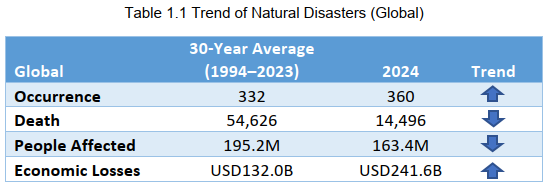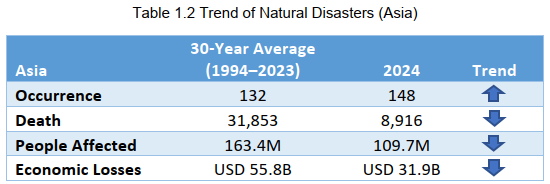Natural Disasters Data Book 2024
Introduction
ADRC publishes the Natural Disaster Databook annually to provide statistical and analytical overview of disaster data. For 2024, ADRC downloaded the datasets from the Emergency Event Database (EMDAT) created on 2 June 2025 and utilized them for this analytical overview. This Databook provides an overview of the trends in occurrences, number of deaths, people affected, and economic losses by focusing on seven disaster types: drought, earthquake, extreme temperature, flood, storm, volcanic activity, and wildfire.
Basic analysis is presented by comparing the 2024 data with the 30-year average (1994–2023) data. General comparisons are provided for the following:
• Comparison of the natural disaster data of 2024 with the 30-year (1994–2023) average data
• Comparison of the climate-related disaster data of 2024 with the 30-year (1994–2023) average data
Note that this Databook only presents general trend data (i.e., occurrence, deaths, people affected, and economic losses). It does not present detailed disaggregated data, such as analysis by gender, location, or sector. In other words, this Databook will not tell you how many of the total deaths are male or female or how many of the houses destroyed are in the rural or urban areas. Instead,this Databook will simply show whether the trend in 2024 is increasing or decreasing compared to the 30-year average (1994_2023).
At the outset, three observations can be highlighted in this Databook. First, disaster occurrences have been increasing but the number of deaths and the number of people affected are decreasing. This trend is observed globally and in Asia. Second, there is an increasing trend of climate-related disasters both globally and in Asia. Third, while the amount of economic losses from disasters is increasing globally, there seems to be a decreasing trend in Asia.
Globally, the number of disaster occurrence in 2024 is higher (360 events) than the 30-year average (332 events), indicating an increasing trend. Also, as shown in Table 1.1, the numbers of deaths and people affected indicate a decreasing trend while the amounts of economic losses indicate an increasing trend.

If we look at Asia, it is notable that the economic losses from disasters showed a decreasing trend in 2024 (USD31.9 billion) than the 30-year average (USD55.8 billion). A decreasing trend in economic losses is a positive indication of effective disaster risk reduction efforts. However, this trend observed in Asia does not necessarily mean a definitive decrease, as there are no 2024 data on economic losses for three of the disaster types (i.e., extreme temperature, volcanic activity, and wildfire) covered in this analysis. This has led to a decreasing trend when we compared the 2024 data with the 30-year average (1993–2023) data. Also, it should be noted that there were huge disasters in 2023 (e.g., Türkiye-Syria earthquakes and South Asia flooding) that could have inflated the 30-year average of economic losses. Other trends, as shown in Table 1.2, the numbers of deaths and people affected indicate a decreasing trend while the number of occurrences indicate an increasing trend.

Climate change is attributed to cause many hazards to become more intense and frequent. In 2024, wildfires, floods, and droughts impacted millions of people across the globe. Severe drought affected millions of people in Zambia, Malawi, and Zimbabwe. Droughts in the Amazon fueled record wildfires in Brazil and Bolivia. Record heatwaves were experienced in Japan, India, Pakistan, Mexico, and across Europe. Devastating floods were experienced across central and eastern Europe. Destructive storms (e.g., Hurricane Helene and Hurricane Milton) made landfall in the United States while super typhoon Yagi caused severe flooding and displacement in Southeast Asia.
Globally, the occurrence of climate-related disasters in 2024 is higher (340 events) than the 30-year average (301 events). As shown in Table 1.3, the number of people affected by climate-related disaster is decreasing while the amount of economic losses is increasing.

In 2024, Asia experienced a wide spectrum of climate-related disasters, including extreme temperature, storms, flooding, and drought. As shown in Table 1.4, the occurrence of climate-related disasters in 2024 in Asia is higher (133 events) than the 30-year average (113 events). The data also indicates that the number of people affected and the economic losses are decreasing.

Table of Contents
1. Introduction
2. Natural Disaster Data
2.1. Global Disaster Data
2.2. Asian Disaster Data
3. Climate-Related Disasters
3.1. Global trend in climate-related disasters
3.2. Asian trend in climate-related disasters

